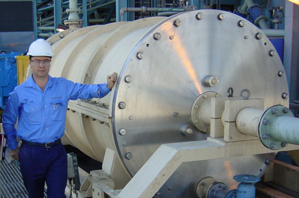Joe Pease (pictured here), former Chief Operating Officer (COO), Xstrata Technology (XT) and Dr Bill Johnson will be inducted into the International Mining Technology Hall of Fame in the Comminution category (sponsored by Gekko Systems) at the gala awards dinner in Denver on February 20th, during SME Conference week.
New technology doesn’t just come into our industry. It is the combination of a set of events, timing and people with passion. If one of these ingredients is missing then the technology doesn’t eventuate. People with passion fill a variety of roles in the technology development. Initial inventors are the source of the “spark”, that important event that brings to light the innovation. As important are the teams of engineers, operators and scientist who work with the inventors to further develop the idea into something that can be touched, be used and mark the way to a commercial product. And finally there are the first Users to adopt the technology – believers who take the risk of breaking away from ‘tried and tested’ routes, hoping to bring to their project advantages that were not possible in the status quo.
Joe Pease has been in the mining industry for over 30 years, in a range of technical and managerial roles. A large part of his career has been at Glencore Xstrata’s Mount Isa Mines (MIM), and more specifically, in the lead/zinc concentrator at that site. During this time, the ‘spark’ of using small scale industrial fine grinding into mineral processing was initiated in the labs at MIM to combat the companies deteriorating ore quality, which lead to the birth of IsaMill™ comminution technology.
However to get to the point of a robust, commercial technology, many steps were needed after the initial spark, lab scale test work and initial prototype development. This is where Joe has played a vital role in the IsaMill story. He knew the fine grained orebodies at Mount Isa, as well as the deposits at McArthur River, needed this technology for their survival and development, and it needed to work. No other technology could grind economically to the sizes that were required to liberate the minerals. Working with engineers, development teams and his operators, Joe was a key player in the advance of the technology at the Mount Isa operations, leading to increase metal recoveries and developing the IsaMill into the robust and accepted technology it is today.
The original detailed flotation studies of the lead-zinc ores at Mount Isa and McArthur River were carried out by Dr Bill Johnson and he defined the requirement for an ultrafine grinding mill. The Netzsch company in Germany worked with MIM to build the early mills and the project became a commercial venture when they were successful. The work has been excellent and the results have been most satisfactory.
The turning around of zinc recovery at MIM and the eventual development of McArthur River based on IsaMill technology, is a credit to the work done by Joe and the rest of the engineers and operators in developing the new technology. Several papers document the success at these operations, Improving Fines Recovery by Grinding Finer, Developments in Milling Practice at the Lead/Zinc Concentrators of Mount Isa Mines Limited from 1990, co-authored by Joe and other engineers, with Joe always keen to discuss with doubters of the new technology and new concentrator practices – “You can grind fine…and you can float fines!”
It was a close fought contest with Washington Samuel Tyler, founder of Haver & Boecker Canada, formerly W.S. Tyler, who led mining innovations with foresight and inventions that continue to impact the international mining industry today. Tyler’s nomination will roll over to the next inductions.










